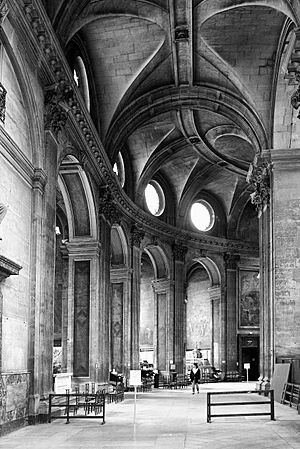Ambulatory facts for kids

The ambulatory (say: AM-byoo-luh-tor-ee) is a special covered walkway. You often find it in large churches, cathedrals, or around a cloister. Think of it as a path that goes around the main part of a building, especially behind the main altar at the east end of a church.
Contents
What is an Ambulatory?
An ambulatory is basically a passage or a hallway. In churches, it usually forms a curved path. This path goes around the main area where the altar is. It allows people to move around easily.
Where Can You Find Ambulatories?
You'll mostly see ambulatories in old, grand churches and cathedrals. They are a common feature in Medieval European church design. They help manage the flow of people. This is especially true during religious ceremonies or pilgrimages.
Why Were Ambulatories Built?
Ambulatories were very useful for several reasons:
- Processions: They provided a clear path for priests and worshippers. They could walk in processions around the church.
- Access to Chapels: Many churches had small chapels built around the main altar. The ambulatory gave people easy access to these chapels.
- Pilgrimages: In the Middle Ages, many people traveled to see holy relics. These relics were often kept in chapels behind the altar. The ambulatory allowed pilgrims to view the relics without disturbing the main service.
- Space and Light: They added more space to the church. They also allowed more light to enter the building.
Images for kids
-
The ambulatory of Santa Maria Gloriosa dei Frari in Venice, Italy.
See also
 In Spanish: Girola para niños
In Spanish: Girola para niños




